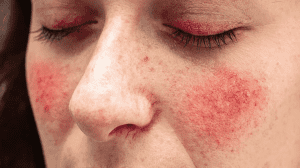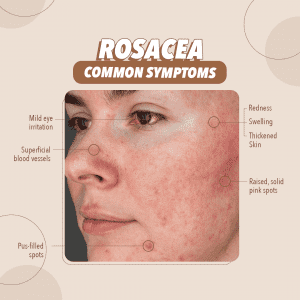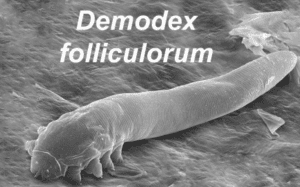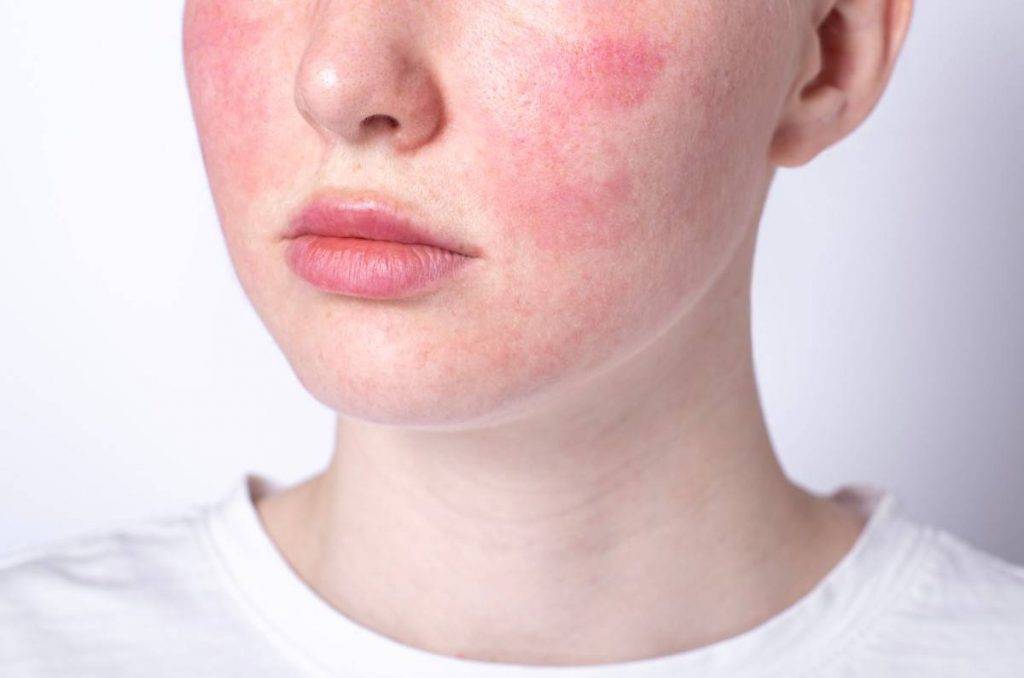Face Up to Rosacea
Rosacea is a common chronic inflammatory disease that presents with recurrent facial redness, flushing, and visible blood vessels. It tends to affect the central portion of the face, including the cheeks, nose, chin, and forehead. It also causes bumps, pimples, and thickened skin around the nose. A study [1] in 2018 concluded that around 5.46% of the population worldwide is affected by this condition, mostly people aged 45-60 years.

Figure 1: Woman with Rosacea
Acne or Rosacea?

You might be wondering, doesn’t this look like pimples as well? Indeed they can sometimes look very similar, but there are some key differences:
| Criteria | Rosacea | Pimples/ Acne |
| Location | Typically affects central portion of face, including cheeks, nose, chin and forehead | Can appear anywhere on the face |
| Texture | Can cause thickened skin and visible blood vessels | Typically raised, red bumps |
| Triggers | Environmental factors (sun exposure, emotional stress, certain foods) | Various factors, including hormonal changes |
| Age of onset | Typically develops in adults over the age of 30 | Can affect people of all ages, but more common in teenagers |
Symptoms
Rosacea can cause a range of symptoms [2], which can vary in severity from person to person. Some common symptoms include:
- Facial redness: This can appear as a persistent blush or flushing that does not go away.
- Visible blood vessels: Small blood vessels may be visible on the face, particularly around the nose.
- Bumps and pimples: These can be small and red, or they may be larger and more inflamed.
- Thickened skin: Over time, the skin on the nose and cheeks may become thickened and bumpy.
- Eye problems: Eye irritation, redness, and dryness.
- Burning or stinging: Some people may experience a burning or stinging sensation on their skin.
- Swelling: In severe cases, face swelling can arise, particularly around the eyes.
It’s important to note that not everyone with rosacea will experience all of these symptoms, specifically, for people living in tropical regions like in southeast Asian countries, if you experience flushes frequently under the sun, it might be a subtle sign of rosacea and require medical attention.

Figure 2: Common Symptoms of Rosacea
If you have any of the above-mentioned symptoms, consult a doctor early to reduce the timeframe of treatment and keep rosacea in remission.
Risk Factors of Rosacea
The exact cause is not fully understood, people with a positive family history, fair skin colour, age over 30, and female gender tend to have an overall higher chance of developing the condition. Some other triggers include:
- Sun exposure: Exposure to sunlight and other sources of UV radiation can trigger or worsen rosacea symptoms.
- Mites infestation: Demodex mites infestation is becoming more recognised as a trigger for the inflammation in rosacea. These microscopic mites are common inhabitants of human facial skin, and they occur in greater numbers on the faces of individuals affected with rosacea [3].
- Food and drinks: Some food and drinks such as hot soup and beverage, alcohol, hot spices and cinnamaldehyde-containing foods like tomatoes, citrus fruits, chocolate have been associated with rosacea flare-ups [4].
- Medical conditions: Rosacea has been linked to certain medical conditions, such as gastrointestinal disorders and autoimmune diseases. These underlying health conditions can stimulate a flushing response and trigger rosacea flare-ups [5,6].
- Medications: Some medications, such as topical steroids, can trigger or worsen rosacea symptoms [7].

Figure 3: Demodex mites live in the follicles of the skin, especially around the eyelids and lashes and feed on dead skin and oils.
Treatment: Lifestyle and Medications
Non-pharmacological treatment starts with lifestyle: the CTMPTM [8] routine from Galderma is one of the key to optimise treatment outcome:
- Cleanse: Cleansing helps to remove dirt, oil, and impurities from the skin, which can exacerbate rosacea symptoms. Affected individuals typically have a defective skin barrier which makes their skin prone to irritation thus it is paramount to opt for a mild, non-irritating cleanser that soothes skin.
- Treat: Facial redness can be treated using Brimonidine gel which narrows the blood vessels in the skin. Ivermectin cream [9] or Metronidazole gel work to treat inflamed bumps and pimples. However if the condition is severe, you may be prescribed with oral medication or non-medicated treatment such as laser surgery or electrosurgery to ease the symptoms [10]. To understand which treatment works best for your condition, consult a doctor or dermatologist.
- Moisturise: Moisturising helps to keep the skin hydrated and prevent dryness, which can worsen rosacea symptoms. When it comes to moisturising, it’s best to stick with lightweight moisturiser.
- Protect: Protecting the skin from the sun is crucial for managing the condition. Sunscreen is a ‘must’ regardless of your skin condition, so opt for one that won’t further clog your pores, such as a light-weight SPF 50+ product to ensure you’re still protected from the sun.
About Galderma
“Findings of this global survey show that regardless of the disease (rosacea or psoriasis) of the face, 90% of the patients surveyed felt their disease was partially or totally uncontrolled, and experienced a similar impact on working life.”
– Beyond the visible: rosacea and psoriasis of the face (2018) [11]
Galderma has always been in the forefront for the research and advancement of rosacea management. Together with stakeholders such as the ROSacea COnsensus (ROSCO) panel, Galderma has contributed to reclassify rosacea subtypes.
Galderma is a global dermatology company founded in 1981, continually focusing on the research, development, and commercialization of innovative solutions for skin health, including prescription medications, over-the-counter products, and aesthetic treatments. The company has a portfolio of products that are used to treat a range of skin conditions, including rosacea, acne, psoriasis, eczema, and aging.
References
- Gether L, Overgaard LK, Egeberg A, Thyssen JP. Incidence and prevalence of rosacea: a systematic review and meta-analysis. Br J Dermatol. 2018;179(2):282-289. doi:10.1111/bjd.16481
- Rosacea symptoms and treatments [Internet]. (2023). Retrieved 12 July 2023, from https://www.nhsinform.scot/illnesses-and-conditions/skin-hair-and-nails/rosacea
- Jarmuda S, O’Reilly N, Żaba R, Jakubowicz O, Szkaradkiewicz A, Kavanagh K. Potential role of Demodex mites and bacteria in the induction of rosacea. J Med Microbiol. 2012;61(Pt 11):1504-1510. doi:10.1099/jmm.0.048090-0
- Searle T, Ali FR, Carolides S, Al-Niaimi F. Rosacea and Diet: What is New in 2021?. J Clin Aesthet Dermatol. 2021;14(12):49-54.
- Wang FY, Chi CC. Rosacea, Germs, and Bowels: A Review on Gastrointestinal Comorbidities and Gut-Skin Axis of Rosacea. Adv Ther. 2021;38(3):1415-1424. doi:10.1007/s12325-021-01624-x
- Jun YK, Yu DA, Han YM, Lee SR, Koh SJ, Park H. The Relationship Between Rosacea and Inflammatory Bowel Disease: A Systematic Review and Meta-analysis. Dermatol Ther (Heidelb). 2023;13(7):1465-1475. doi:10.1007/s13555-023-00964-6
- Bhat YJ, Manzoor S, Qayoom S. Steroid-induced rosacea: a clinical study of 200 patients. Indian J Dermatol. 2011;56(1):30-32. doi:10.4103/0019-5154.77547
- Goh CL, Wu Y, Welsh B, et al. Expert consensus on holistic skin care routine: Focus on acne, rosacea, atopic dermatitis, and sensitive skin syndrome [published correction appears in J Cosmet Dermatol. 2023 Jun;22(6):1933]. J Cosmet Dermatol. 2023;22(1):45-54. doi:10.1111/jocd.15519
- Schaller M, Almeida LM, Bewley A, et al. Rosacea treatment update: recommendations from the global ROSacea COnsensus (ROSCO) panel. Br J Dermatol. 2017;176(2):465-471. doi:10.1111/bjd.15173
- Raedler LA. Soolantra (Ivermectin) 1% Cream: A Novel, Antibiotic-Free Agent Approved for the Treatment of Patients with Rosacea. Am Health Drug Benefits. 2015;8(Spec Feature):122-125.
- Galderma global research reveals struggles of people with rosacea and psoriasis of the face experiencing a lack of control and impact on mental wellbeing [Internet]. (2020). Retrieved 12 July 2023, from https://www.galderma.com/news/galderma-global-research-reveals-struggles-people-rosacea-and-psoriasis-face-experiencing-lack

